Everything you need to know to create jaw-dropping outdoor wedding photos
A trendsetting wedding photographer breaks down her process for creating magical images using Lightroom and Photoshop.
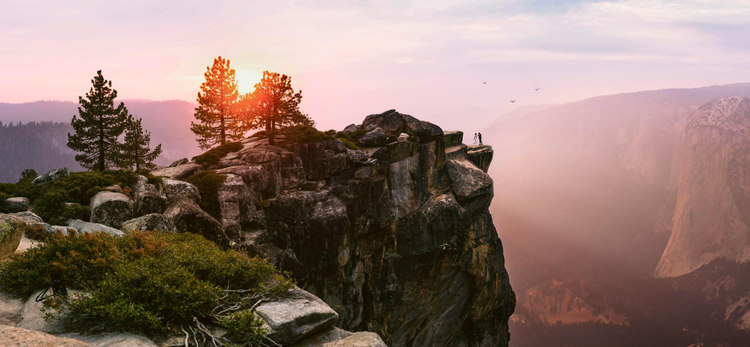
Image source: Marlies Hartmann.
Wedding photographers were already trailing after more and more starry-eyed couples through redwood forests and sand dunes before 2020 arrived. Overnight the industry transformed as new restrictions shrunk parties and pushed even more weddings outside. The subsequent rise in elopements and “minimonies” means that to shoot a wedding nowadays often entails wrangling more with nature than with big, boisterous families.
Marlies Hartmann is a Santa Monica-based wedding photographer whose work has appeared in Vogue, Glamour, and Martha Stewart Weddings, among others. She has also witnessed the rise of outdoor wedding scenes. “Even before 2020, there was a budding genre of ‘adventure elopements,’” she said. “But people weren’t contacting me about it personally.”
Now she hears from couples who say, “Okay, if we can’t have the big wedding that we planned, then we want to create this really amazing adventure for us to celebrate our wedding day.”
Back to basics
Having experience shooting in the great outdoors doesn’t hurt, but you don’t need to be a professional landscape photographer to thrive in this new era of wedding photography. Hartmann got her start taking headshots before she moved into wedding photography. In the past, most of the weddings she shot took place at resorts and other types of event centers.
But when it comes to the difference between a great wedding photo and one that makes it into a frame and onto the couple’s mantle, she is adamant it all comes down to the same element. “A hundred million percent, lighting is the main thing,” Hartmann said. And that is true whether a person is shooting in a hotel ballroom or at the foot of the Matterhorn.
When capturing images outdoors, she always aims for time with the couple around “golden hour,” when the sun is flirting with the horizon. Doing so helps her capture the warm, romance-soaked images couples hire her for. Of course, good weather and concrete schedules are never guaranteed. Clouds roll in. Ceremonies start late and run long. It is in those moments that Hartmann kicks into high-gear, creating her own golden hour using a flash modifier known as the MagSphere, a full CTO gel, a low f-stop, and a long, wide open lens.
“Even though I’m primarily a natural-light photographer, I need to have those tools and know how to use a flash so I can still deliver the quality of work that my couples expect and are paying for,” she explained.
The final touches
This same attention to detail during shooting applies to the editing stage. “I’m a big believer in Lightroom and Photoshop,” Hartmann said. She generally begins in Lightroom with her favorite presets and some basic tonal adjustments. Next, she turns to Photoshop for the finetuning. Part of her work in this final stage is subtraction — cloning out distracting fence posts and AC vents. Other times, she is in the business of addition, be it dodging light on a bride’s face for drama or brushing in some haze around a pair of windows to up the ambience. “I am making works of art for my clients.”
With this in mind, she is not shy about erasing elements, like trees that clutter the frame, or inserting the Milky Way into an otherwise starless night. In landscape photography, the scenery is the story, but for Hartmann, its primary purpose is to be a backdrop for the couples she photographs.
Take, for instance, the before and after images below. For this shot, taken in Yosemite, Hartmann started in Lightroom, adjusting the white balance and exposure and applying a preset developed by the brand DVLOP that she then tweaked slightly.
“I use presets a lot as a base,” Hartmann said. “Having consistent toning is very important to me.”
From there, she switched over to Photoshop and goes to work making the couple shine. First she modified the perspective and made a few profile corrections with the transform tool before applying a radial filter around the couple’s faces. Next she lowered the exposure around them and used a brush to brighten some of the highlights on the bride’s dress. A graduated filter on the top left corner enhanced the sky and its colors. Finally, she slipped a similar image with a bit more wall and dress underneath to make up for where she had cropped it with her camera.
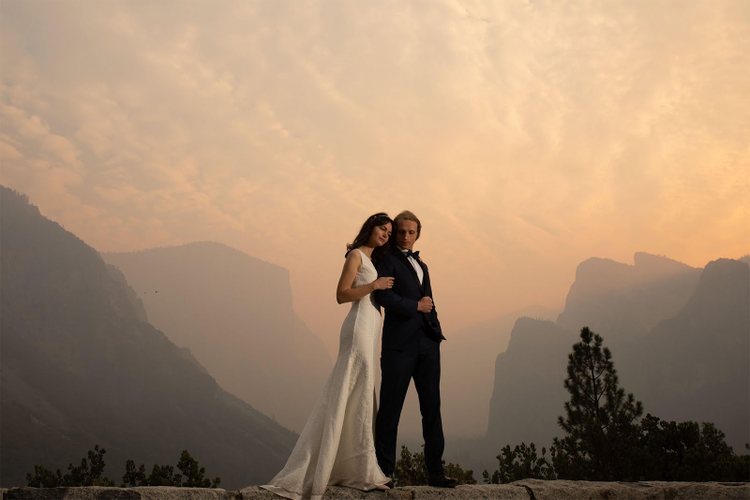
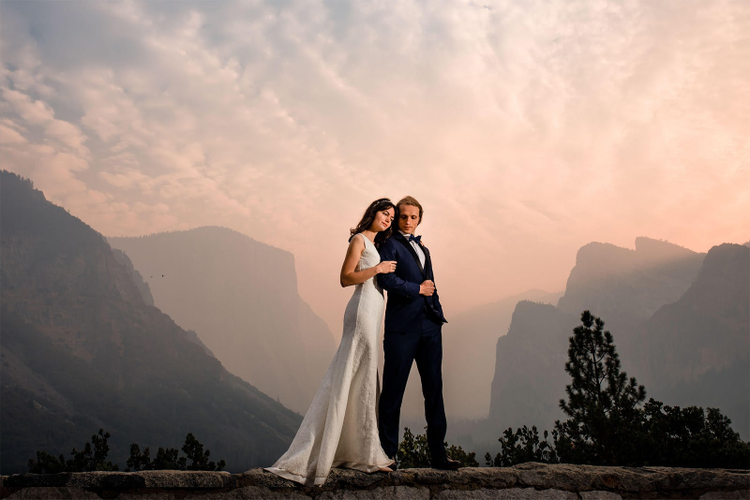
For this photo, shot in Yosemite National Park, Marlies started in Lightroom with tailored presets before exporting the image to Photoshop to achieve the result, shown in the bottom image.
Hartmann took a similar approach with the below images, captured at the Houdini Estate in Los Angeles, starting again with a DVLOP preset she then tweaked. From there, she adjusted the white balance, increased the exposure, and used a radial filter to burn around the couple. Next, she used Photoshop’s heal and clone tools to replace the swan statue with foliage and rock, and a brush to burn many of the highlights around the bride and groom. Finally, she cropped the image to make it horizontal.
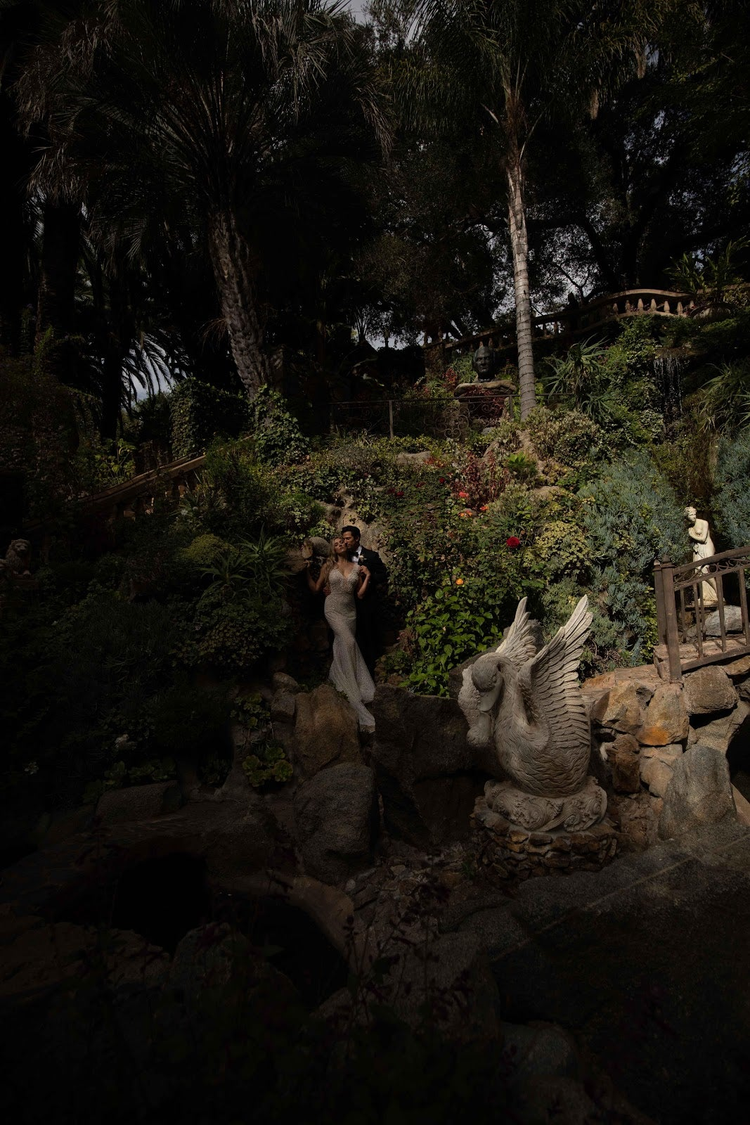
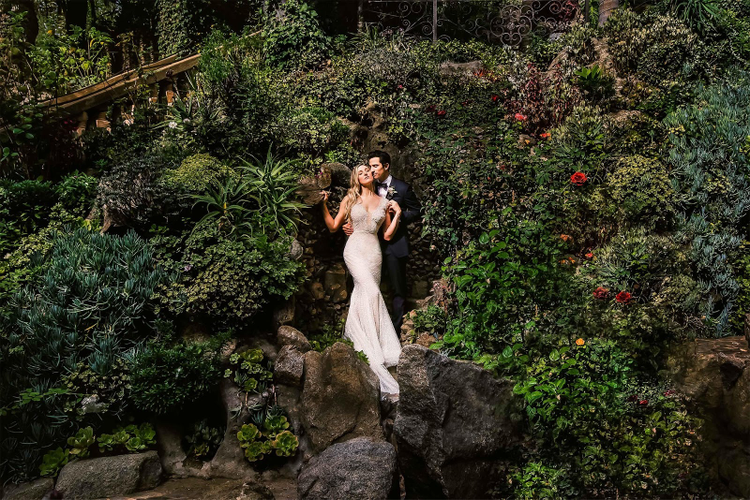
To create the image on the bottom, Hartmann started again with presets in Lightroom before moving to Photoshop for extensive edits.
The trick to mastering the editing stage is knowing when to stop. “It’s good to step away from a photo,” she said. “Another photographer friend of mine calls it ‘letting it bake.’ I’ve edited photos where in the moment I think it’s perfect. And then I come back and I’m like, ‘Oh, nope.’”
For her final step, she takes inspiration from the world of fashion. “Coco Chanel always said that right before you leave the house, you should take off one thing. I think it’s the same with photos. So many photographers take it too far, whether it’s adding too much dehaze or going too pastel or overexposed. Step away, let it bake, and then come back and take off that last piece of jewelry.”
Looking toward the future
Whether or not mountainside micro weddings are here to stay is anyone’s guess. But Marlies feels confident 2020 has accelerated at least one trend that is unlikely to reverse anytime soon, and that is an increased focus on people rather than pageantry.
“It’s becoming more about the couple and why they’re getting married in the first place, and less about the show-stopping spectacle of it,” Hartmann explained. She believes this is a direct result of a greater “appreciation for connection and the privilege of being together.”
For wedding photographers, this means taking fewer images of shoes hanging from chandeliers, or rings perched on a satin pillow. “Clients would much rather have a photo of their grandmother’s hands holding the bride’s shoes, or the ring bearer playing with the rings.”
Hartmann summarizes the future of wedding photography this way: “It’s details with heartbeats.”
Check out Adobe’s guide to wedding photography for shot lists, equipment recommendations, and more. For a beginner’s guide to landscape photography, click here.